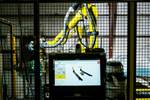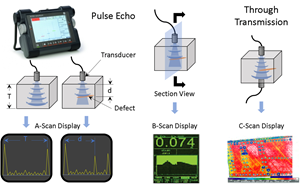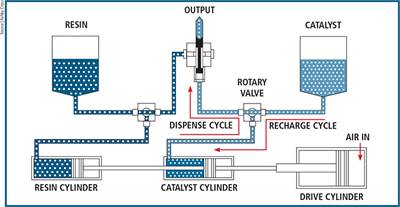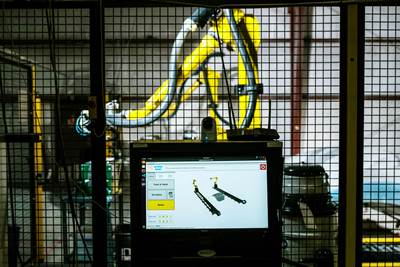The PK2D two-component meter/mix dispensing system by Fluidic Systems for vacuum-assisted resin transfer molding (VARTM). Source (All Images) | Fluidic Systems
Meter/mix dispensing (MMD) equipment was developed to accurately proportion and blend two-component thermosets. The development of epoxy and polyester resins in the 30s and 40s and their rapid application growth in the 50s and 60s generated a need for these dispensing systems. The first machines were two-component resin proportioners, and with the adaption of disposable mixers in the early 70s the metering/mixing industry was born.
Early MMD applications for epoxy/polyester resins were for laminating and glass fiber-reinforced plastics (GFRP). Today, composites applications are wide-ranging. Epoxy liquid shim is used for structural bonding of aerospace composite assemblies, honeycomb edge fill and honeycomb insert potting is used for installing fasteners, and fiber pultrusion machinery uses MMD for resin injection into the molding die. MMD is also often used as a central fill station for loading disposable cartridges for remote composite applications on the factory floor.
Today, various MMD types can be used effectively, provided they are compatible with meeting the material and process specifications. This equipment must be accurate, reliable and durable. Moreover, manufacturing integration of an MMD can range from simple to highly complex. Therefore, there are some important considerations when selecting the proper system.
System considerations
The first factors to consider include material and process specifications:
- Thermoset resin type — epoxy, urethane, acrylic, polysulfide, silicone, etc.
- Plural resin components — two or three
- Resin manufacturer documentation — technical data sheet (TDS), material safety data sheet (MSDS)
- Certifications and compliance — UL, CSA, Class I Div 1, Class I Div 2, CE
- Dispensing parameters — mix ratio, flow rate, shot size, work life, duty cycle/output
- Peripheral equipment options — feed pumps, agitation, heating, hose gantry crane, mobile cart, cartridge loader, etc.
- Automation and/or robotic integration
- Manufacturing environment — ambient or temperature-controlled, hazardous or nonhazardous.
Fixed vs. variable mix ratio
Composite applications like race car spoilers (bottom image) that are processed via infusion (RTM, VARTM, etc.) benefit from MMD’s accurate resin/fiber control.
In dispensing equipment, fixed and variable mix ratios refer to the way in which each system controls the proportion of different components being dispensed. Fixed mix ratio refers to the relative volume of the resin cylinder (part A) compared to the volume of the catalyst cylinder (part B); it is fixed. Variable mix ratio is the same with the exception that the volume of the catalyst can be changed by adjusting the stroke length of the (part B) cylinder or by changing the velocity of the (part B) pump relative to the velocity of the resin (part A) pump.
Fixed ratio machines lower cost and commonly used with close mix ratio resins, such as 1:1, 2:1 or 4:1 parts by volume (PBV), whereby mix ratio accuracy is forgiven. These mix ratios normally do not require fine adjustments. Variable ratio machines usually cost more and are commonly used with wide mix ration resins from 1:1 to more extreme ratios such as 100:1 parts by weight (PBW) and more complex and sensitive formulations, whereby mix ratio accuracy is critical. Mix ratio can be finely adjusted for fluid dynamic anomalies such as resin compressibility. Alternatively, variable ratio machines can be purged and cleaned for a different resin formulation with a different mix ratio.
Pump drives
Pump drives are the driving force behind material flow in MMD systems, moving materials from their source (tank reservoirs) to the dispensing nozzle.
Pneumatic pump drives are simple, low maintenance (single action on/off dispense) and low cost. They are safe in hazardous zones, but offer low-precision metering.
Hydraulic drives are good for continuous high flow with incompressible, high-viscosity and abrasive compounds. Their downside is a slow dynamic flow response, high maintenance requirements and pump oil leakage.
Stepper motor are ideal for low-load applications such as gear pumps. While more cost-competitive than servomotors, their open-loop control accuracy is compromised at high pressures with high-viscosity resins.
Servomotors, good for dynamic flow ramping, are higher in cost and more complex. High-speed torque with closed-loop feedback provides high mix ratio accuracy and flow rate under high load applications.
Controls
MMD controls enable accurate material dispensing and mixing, providing advantages like precise volume control, consistent mixing ratios and repeatable dispensing. The control type used is based on the complexity and accuracy of the machine.
Human-machine interfaces (HMI) are commonly used for inputting machine parameter settings and operational functions. There are different HMI types based on MMD machine complexity. Common types include push button panels, alphanumeric (LCD/LED) and touchscreen panels (GUI+Touch).
Enhanced accuracy, process control and consistent results are achieved with the correct dispensing equipment.
Push button panels. These are the simplest interfaces with buttons, switches and indicator lights. They are low cost and durable, but have limited data display and flexibility for modifications or expansions.
Text-based HMI (LED/LCD displays). These are alphanumeric displays showing system status or error codes. They are simple and relatively inexpensive, but limited functionality and interaction.
Graphical touchscreen HMI. Color touch screen displays that are integrated into control panels. They are intuitive, enable graphic customization and can monitor trending and alarm handling. Ethernet can be used for remote diagnostics and reprogramming. This option is the costlier of the three.
Monitoring
All operational control functions should be continuously monitored for fail-safe shut down protection. Key parameters include mix ratio, over/under pressures, valves and peripheral equipment functions. Effective monitoring reduces waste, prevents defective parts and minimizes downtime.
Meter/mix composite applications
Fluidics PK2D equipment directly edge fills composite honeycomb.
Composite bonding. Structural adhesive bonding of composites can be directly from the meter/mix machine via A/B dispense hoses attached to a manual or robotic dispense gun. Alternatively, the system can be used indirectly as a remote fill station whereby disposable cartridges are loaded and disseminated for immediate use.
Insert potting. Direct or cartridge fill adhesive application.
RTM. Direct application using accurate metered flow for resin/fiber control.
Filament winding/pultrusion. Resin bath level control for filament winding applications. Resin die injection for pultrusion applications.
Edge fill machines. Direct honeycomb edge fill of exposed core with syntactic epoxy fire-retardant compound.
Sealants. Direct or cartridge application of polysulfide sealant.
Meter/mix pump types
MMD machines are based on the type of metering pump used, including piston, rod, gear and progressive cavity. Metering pumps are positive displacement (PD) pumps that enclose a precise fixed fluid volume and mechanically move it through the pump. By comparison, bulk transfer pumps are not precision volume pumps; rather, they are designed for moving large volumes of liquid efficiently. Examples include centrifugal, rotary vane, plunger and basic piston transfer pumps.
There are many types of PD pumps. The most commonly used versions for meter/mixing thermosets are identified below.
|
Pump Type |
Motion Type |
Flow Characteristic |
|
Gear |
Rotary |
Continuous flow |
|
Progressive cavity |
Rotary |
Continuous flow |
|
Piston |
Reciprocating |
Single action: Shot/reload Double action: Continuous flow |
|
Rod |
Reciprocating |
Single action: Shot/reload Double action: Continuous flow |
|
Types of positive displacement metering pumps commonly used for meter/mix/dispensing systems. Source | Fluidic Systems |
||
Gear pump
A gear pump operates by trapping a fixed volume of resin between interlocking gears and transferring it through the pump in a continuous, metered flow. As the gears rotate, they create a sealed displacement chamber that moves the resin efficiently. Gear pumps use stepper or servomotor drives for precise fluid metering.
Progressive cavity pump
A progressive cavity pump consists of a spiraled rotor shaft enclosed within a spiraled elastomeric cavity. As the rotor turns, it forms a series of sealed cavities that move the resin forward, ensuring a consistent flow. Progressive cavity pumps use stepper or servomotor drives and are ideal for handling viscous and shear-sensitive fluids.
Piston pump
A piston pump functions similarly to a syringe, using a cylinder and a piston/seal assembly to control fluid displacement. The piston forms a tight seal against the cylinder walls and moves in a reciprocating motion, alternating between dispensing and reloading cycles. The operating cycle comprises the piston moving forward, displacing the resin from the cylinder to dispense. The piston then retracts, allowing the cylinder to refill with resin.
Types include single-action piston pumps, which alternate between dispensing and reloading, and double-action piston pumps, which provide continuous flow by using two chambers — one dispensing while the other reloads.
Both types require inlet and outlet valves to regulate the reciprocating flow. Piston pumps incorporate pneumatic, hydraulic or servo drives, and are designed for high-accuracy resin metering applications.
Rod pump (rod displacement pump)
A rod pump consists of a cylinder, a pump rod and a stationary rod seal cartridge nut. Unlike a piston pump, where the piston moves within the cylinder, a rod pump features a fixed seal at the top of the cylinder, through which the pump rod reciprocates. The key advantage is that the rod does not contact the cylinder walls, reducing wear and friction. The operating cycle begins as resin is displaced by the volume of the rod moving through the fixed seal. To reload, the rod retracts, allowing the cylinder to refill.
Types again include single-action and double-action pumps, with the same differentiation as above. Like piston pumps, rod pumps require inlet and outlet valves for proper reciprocating function. Rod pumps use servo, hydraulic or pneumatic drives and are designed for high-accuracy fluid metering.
Types of mixing
The last part of the process is the actual mixing. This can be accomplished manually, with a static mixer or dynamic mixer.
Manual mixing. For small batch, the material can be mixed manually, with tools such as spatulas, stir sticks or paddles. It is a good way to validate the process and to start a low production run. This depends heavily on the operator skill, it is not very repeatable and is prone to air entrapment.
Static mixer. It is by far the most common method of automated mixing. It uses a disposable or reusable tube with internal elements that split and fold the materials together as they pass through. This method assures a repeatable result, since the static mixer has a fixed geometry, it reduces clean up time, especially with the disposable mixer. Certain materials that have different viscosities, rheology and/or wide ratios can not be mixed this way.
Dynamic mixer. Uses a powered device (motorized mixing head or impeller) to actively blend materials in a mixing chamber. This is ideal for complex and sensitive formulations. It is more complex and costly, requiring motors, controls and maintenance. It also requires flushing and disassembling between materials, and can generate heat or material degradation due to shear.
Selecting a cost-effective machine
Peripheral equipment options like this PK1D cartridge loader are important to consider when determining the right equipment for your application.
Depending on the material and process specifications selected, the type of MMD machine and options chosen can be as simple as a basic benchtop system with a 1:1 mix ratio for a low/medium-viscosity resin using a pneumatic meter/mix pump, costing roughly $20,000. A more optimized and automated mix/meter machine with integrated peripheral options could be specified as follows, and cost up to $200,000:
- Electronic control system incorporating PLC, touchscreen controls, fail-safe function sensors, Ethernet reporting/diagnostics/reprogramming.
- Servomotor pump drives (closed-loop feedback) with highest metering accuracy.
- Continuous flow metering pumps providing low shear, pulse-free flow.
- Variable mix ratio adjustments for compressibility.
- Peripheral equipment options (liquid levels, heaters, hose gantry, cartridge loader, etc.).
- Electrical certifications.
- Robotic integration.
At the end of the day, consulting equipment suppliers is a good way to help determine which MMD system will best meet your composites processing needs. When considering suppliers, it is important to do some research and prepare in your own way. Consulting with your resin manufacturer and/or supplier for equipment referrals or checking out equipment manufacturers’ customer references is a good first step. Once you find a potential supplier, creating and submitting a comprehensive materials and process specification to the supplier for review and written approval, and asking for a 100% money-back guarantee based on mutually agreed metrics, will ensure all your bases are covered.
About the Author
Bruce H. Menk
Bruce H. Menk spent the first 29 years of his career in sales and application engineering for thermosetting adhesives, encapsulants and coatings at companies like Dow Corning Corp. and K.R. Anderson Co. Inc. Menk founded Fluidic Systems (Santa Ana, Calif., U.S.) in 2000 where he is currently president.
Related Content
Nondestructive inspection methods available to composites manufacturers
An overview of composite laminate inspection techniques ranging from manual testing methods to more advanced, noncontact options.
Read MoreTroubleshooting thermoplastic composite stamp forming
Understand the basic science of TPC stamp forming, a manufacturing process steadily gaining momentum in aerospace and mobility applications thanks to its rapid forming, short cycle times and automated methods.
Read MoreGuidance for the thermoforming process
A briefing on some of the common foam core material types, forming methods and tooling requirements.
Read MoreRevisiting the double vacuum debulk process
Evolution of the double vacuum debulk (DVD) process over the years continues to advance its “near autoclave quality” for low-void, highly compacted repair patches.
Read MoreRead Next
Meter/mix/dispense machines: Doubling down on control
The latest equipment solutions deliver lower costs, faster cycle times and better part properties.
Read MoreAI-powered robotic solutions support high-mix manufacturing
AI startup offers automation innovations for high-mix, high-variability, manual surface finishing applications.
Read MoreNext-gen fan blades: Hybrid twin RTM, printed sensors, laser shock disassembly
MORPHO project demonstrates blade with 20% faster RTM cure cycle, uses AI-based monitoring for improved maintenance/life cycle management and proves laser shock disassembly for recycling.
Read More













